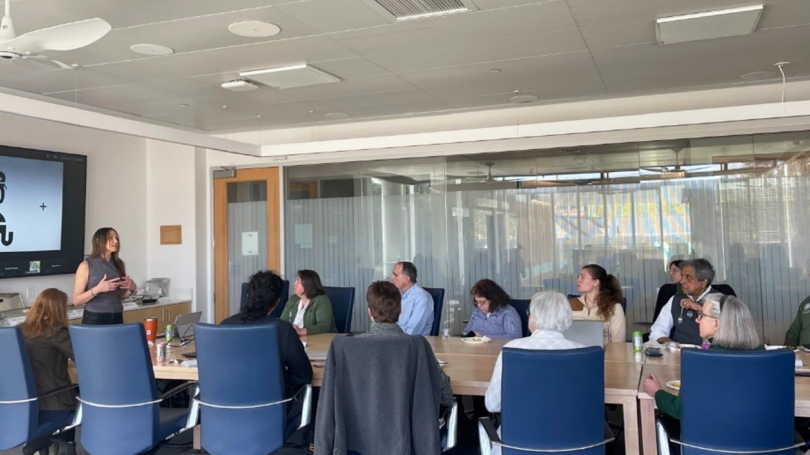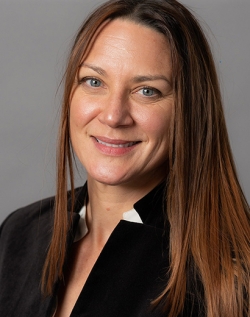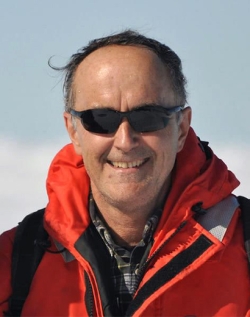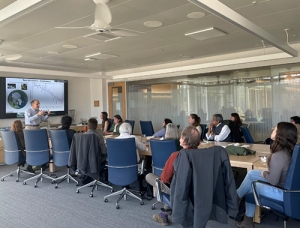Bringing together faculty and research staff from across the university, the April Faculty Seminar Series featured presentations on advancing climate communication through neuroscience and the thermodynamics and implications of Arctic sea ice loss.
The seminar spurred interdisciplinary conversations around how we observe, measure, and communicate the effects of climate change to motivate meaningful action.
"The Irving Institute Faculty Seminar Series fosters cross-disciplinary collaborations that otherwise might not happen," said Honor Passow, Senior Fellow at the Institute. "Having two faculty present distinct projects in a single session enhances the potential for exchange."
The Science of Persuasion: How Visual Attention and Beliefs Shape What We See and What We Do
Kimberly Rose Clark, Lecturer, Department of Psychological and Brain Science, presented a talk titled "Bridging the Intention-Behavior Gap: Applying Neuroscience for More Effective Climate and Energy Communications."
Clark leads the DartDIRECT Lab (Dartmouth's Initiative for Energy and Communication Transformation), a pioneering 'research-and-action hub' that conducts interdisciplinary studies on the societal impacts of climate change and energy transition.
Founded in response to two persistent issues — overreliance on self-reported data and the inefficacy of one-size-fits-all messaging — the lab applies neuroscience to measure how people process and react to messaging about the climate and energy in real time to predict sustainable behaviors in the lab and at scale.
Clark highlighted long-standing challenges in climate and energy communications, referencing the Intergovernmental Panel on Climate Change's (IPCC) decades of reports that, despite urgency, have had limited success in driving behavioral change. At the root, Clark argued, are flawed measurement techniques which often fail to capture the critical gap between intention and action.
"One thing is quite clear — we need to up our communications game," stated Clark. "It's not just the content that is important; it is how you frame it to be most receptive to the most people."
She emphasized that people interpret content through their own biases, experiences, and political ideologies.
Clark drew attention to how advertisers have successfully harnessed cognitive biases — such as scarcity tactics and the bandwagon effect — to influence behavior. The DartDIRECT Lab is applying similar behavioral science tools to test the efficacy of climate and energy messages, exploring how positive versus negative message framing impacts reception across political lines.
"We're not just passive viewers; our beliefs guide our attention," Clark explained.
In studies at the lab, participants are provided with messaging about the climate. As subjects engage with the messaging, their biometric data, such as eye tracking, facial affect, and heart rate, are measured. Participants are also asked to gauge their explicit judgments of the messages. Clark's team is also collaborating with a partner lab at Middle Tennessee State University to gather data across diverse demographic groups.
Preliminary results show differences in how liberals, conservatives, and independents respond to various framings of climate messaging, underscoring the importance of tailoring its content and tone.
"If you understand what tools, or visual decision utilities, people are using to make decisions," said Clark, "you can make those tools more salient in your communications."
Clark closed by emphasizing the importance of embracing data-driven, psychologically attuned approaches to communication to create more effective messaging for climate and energy action.
"If we know someone's ideology and the valence of a message, we can predict which decision utilities they'll use to evaluate it," she said.
Shifting from how to reach the right audiences with the right messages, the seminar then focused on capturing the right data at the right time — and how decades of Dartmouth research is shaping what we know about Arctic sea ice.
Sea Ice as Signal and System: Understanding Its Role in Arctic Climate Dynamics
Donald Perovich, Professor of Engineering, Thayer School of Engineering, presented a talk titled "The Next Best Thing to Being There: Autonomous Observations of Arctic Sea Ice."
Perovich offered a data-rich overview of the evolving Arctic sea ice system, drawing on nearly five decades of satellite and field-based observations.
"From a climate perspective, the reason we're interested in sea ice is that it has a dual role: both as an indicator and an amplifier of climate change," he said.
In his research, Perovich explores the changing thermodynamics of the Arctic system: the interplay of atmospheric warming, ocean heat flux, and a thinning, increasingly mobile ice pack.
Perovich explained that most Arctic sea ice is relatively young, ranging in age from just a few days to several months, and rarely more than a few years old.
He noted that satellite data has documented a steady decline in the area covered by ice and the near disappearance of multiyear ice. While the physical footprint of ice loss is vast, it is just a thin veneer, only a couple of meters thick. Perovich stressed that the structural changes — loss of area, age, and seasonal predictability — are all consequential.
"This record," Perovich pointed out, "shows us what's been happening. But it doesn't show us how it's happening." That's where additional data is needed.
While traditional data-collection methods like ablation stakes have advantages, they are limited to a single location and require on-site monitoring, which is a rare opportunity. Perovich's team has developed an autonomous alternative: seasonal ice mass balance buoys (SIMBs), designed to capture ice growth and melt data remotely across multiple locations.
Developed over 25 years and refined by Thayer alumni during their graduate studies, Cameron Planck Th '21 and James Whitlock Th '18, the buoys are equipped with GPS, barometers, and vertical temperature sensors spanning the atmosphere, snow, ice, and upper ocean. Data is transmitted every four hours via satellite, allowing researchers to assess snow depth, ice thickness, surface melt, and bottom melt in near real-time.
"From there we can determine what the snow depth is, and the ice thickness; we can see how much ice growth there is, how much surface melt in the summer, and how much bottom melt," explained Petovich. "The data gives us insights into growth versus melt, surface versus bottom melting, and we can start to examine the drivers of melt."
The buoys have shown that since 1998, bottom melt has dominated over surface melt nearly every year — a clear signal of oceanic forcing from below.
"The atmosphere is warming up some, but the real story is in the ocean," stated Perovich.
This trend suggests a shift in the mechanisms driving sea ice loss, reinforcing the need to treat Arctic change as both an oceanographic and atmospheric issue.
Today, these autonomous buoys are integrated into the Arctic Observing Network (AON), with data archived through the National Science Foundation (NSF) Arctic Data Center, National Oceanic and Atmospheric Administration (NOAA), and the National Center for Environmental Information (NCEI).
The insights emerging from the data are as expansive as the Arctic's vanishing ice.
"These changes are impacting local communities; they're impacting tourism," said Perovich.
He pointed to changing ecosystems, increasing interest in Northern shipping routes, and the emergence of the Arctic as a space of resource competition.
His conclusion was a reminder that the Arctic is not a contained system.
"What happens in the Arctic doesn't stay in the Arctic," said Perovich. "It's having a direct impact on mid-latitude weather. So there are consequences to these things today."
Continued Collaboration
The interdisciplinary engagement fostered by the Faculty Seminar Series extends beyond the events themselves.
"The format encourages robust discussion during sessions and in-depth conversations afterward," continued Passow, when discussing her involvement with the series this year. "At recent seminars, faculty and researchers from engineering, business, psychology, and medicine connected and scheduled follow-up meetings for future collaboration."
Upcoming Seminars
You can attend the Faculty Seminar Series through live online streaming or in person at the Irving Institute.
The final seminar of the 2024-2025 academic year will be on Friday, May 16. Learn more and register.
Faculty and researchers who are interested in presenting in the series are invited to become Irving Institute Affiliates.



